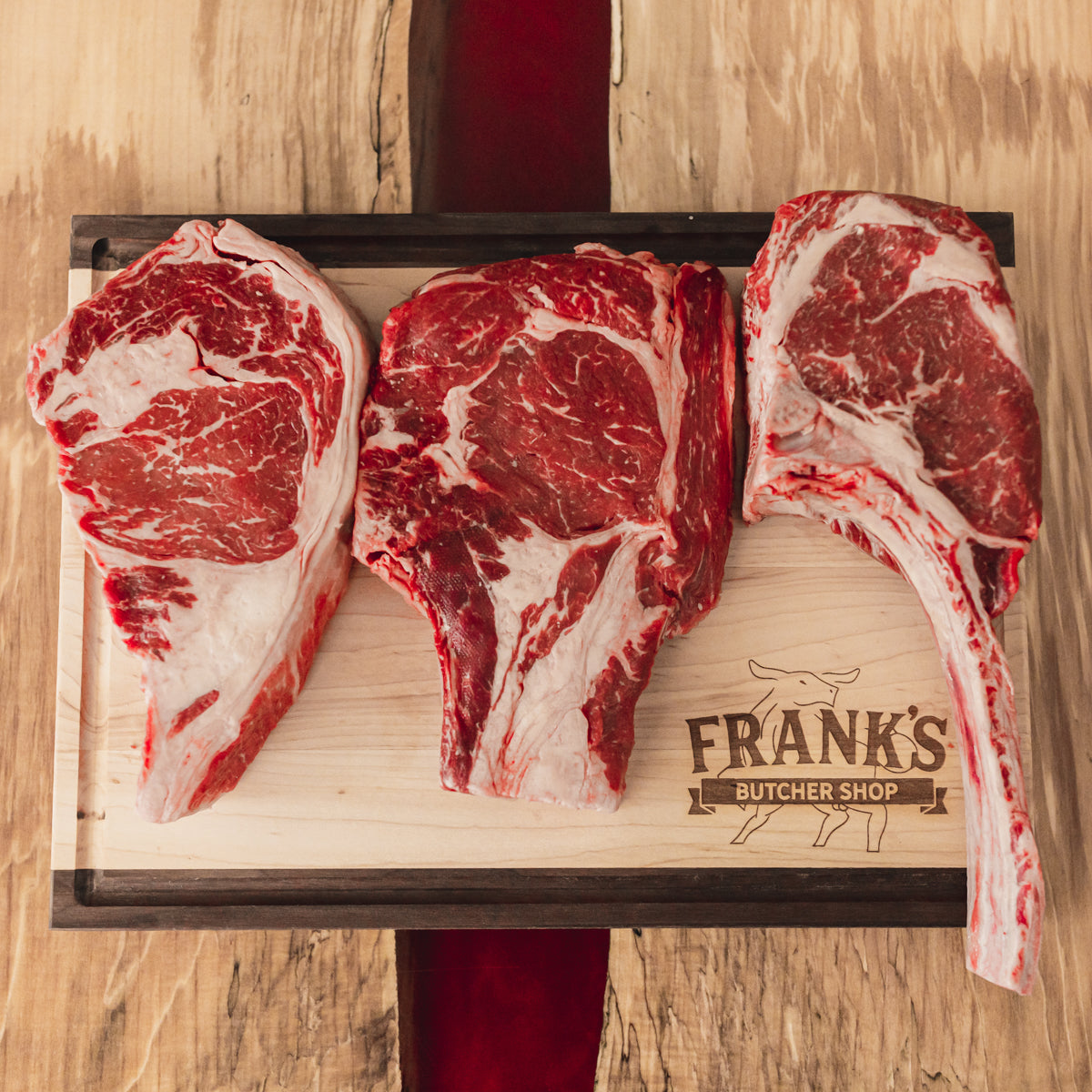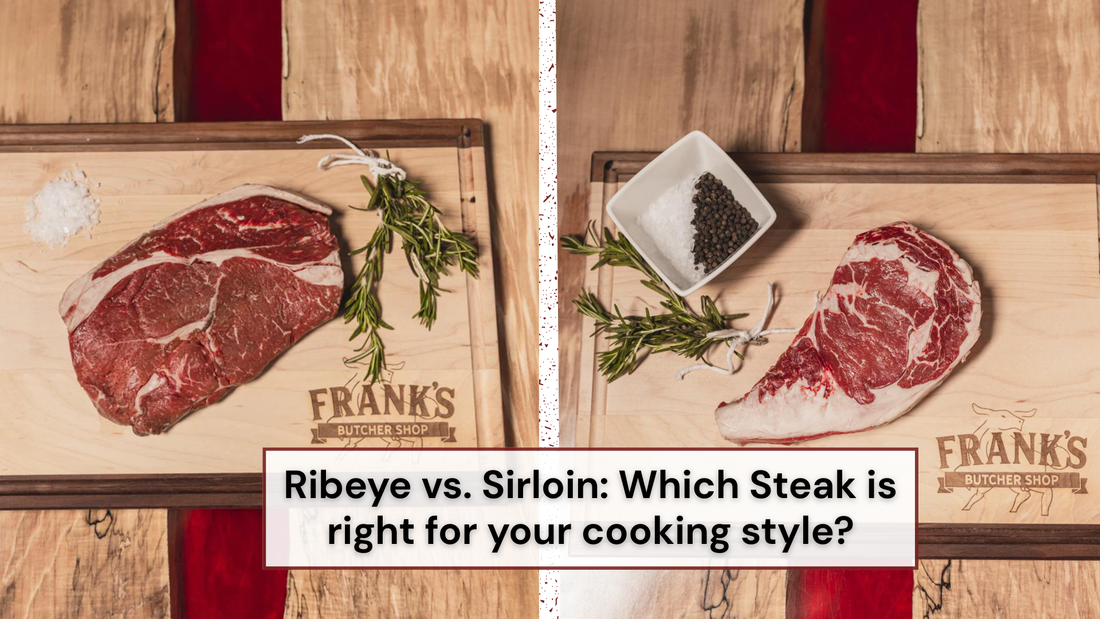If you love a good beef steak, you’ve probably faced the classic dilemma: should you choose a juicy ribeye or a hearty sirloin? Both cuts are favorites at the butcher counter, but they shine in different ways depending on how you like to cook, your flavor preferences, and even your budget.
Let’s break down everything you need to know so you can pick the perfect steak for your next meal.
Understanding the Cuts: Ribeye and Sirloin
Before you fire up the grill or heat your skillet, it helps to know what sets these steaks apart.
What Is Ribeye?
Ribeye steaks come from the rib section of the cow. This area gets little exercise, so the meat is beautifully marbled with fat, making it extra tender and flavorful. When you bite into a ribeye, you get a rich, buttery taste with every mouthful. This marbling melts as it cooks, basting the meat from within and giving it that signature juiciness and melt-in-your-mouth texture.
Ribeye is often called the “king of steaks” and is a top pick for steak lovers who want a, restaurant-quality experience at home.
What Is Sirloin?
Beef Sirloin is cut from the rear back portion of the cow, closer to the hip. Sirloin steaks are leaner than ribeye, with less marbling but plenty of robust, beefy flavor. The texture is firmer, and the flavor is straightforward-meaty and satisfying without being too fatty.
Sirloin is a favorite for those who want a leaner steak that’s still tender and full of flavor, especially when cooked right.
Key Differences: Ribeye vs. Sirloin Steak
Let’s stack these two steaks side by side:
|
Feature |
Ribeye Steaks |
Sirloin Steak |
|
Marbling |
High (lots of fat) |
Low to moderate (leaner) |
|
Flavor |
Rich, buttery, luxurious |
Beefy, bold, straightforward |
|
Texture |
Very tender, juicy |
Firm, slightly chewy |
|
Best Cooking Methods |
Grilling, broiling, pan-searing |
Grilling, pan-searing, stir-frying |
|
Price |
Higher |
More affordable |
|
Health |
Higher in fat/calories |
Leaner, lower in fat |
Which Steak Matches Your Cooking Style?

• For the Grill Master
If you love grilling, ribeye steaks are a dream. The marbling ensures the steak stays juicy, even over high heat. Just watch for flare-ups from the fat drippings. A simple seasoning of salt and pepper is all you need, let the meat’s natural flavor shine.
Sirloin steak also grills well, but because it’s leaner, it cooks faster and can dry out if overdone. Keep an eye on it and aim for medium-rare or medium for the best texture.
• For Quick Weeknight Dinners
When you need dinner on the table fast, sirloin steak is your friend. Its lean profile means it cooks quickly in a skillet or even sliced thin for stir-fries. It’s also perfect for marinating, which can add moisture and flavor.
Ribeye, while delicious, is thicker and takes a bit more time and attention to cook just right. Save it for nights when you can savor the process.
• For Special Occasions
Nothing says celebration like a thick, juicy beef steak. Ribeye’s tenderness and flavor make it the star of any special meal. Serve it with classic sides and a pat of butter for a steakhouse experience at home.
Sirloin can also impress, especially when cooked and sliced properly. It’s a great choice for family gatherings or when you’re feeding a crowd on a budget.
How to Cook Each Steak Perfectly
Ribeye Steaks
• Grilling: Preheat your grill too high. Sear the steak for 4-5 minutes per side for medium-rare. Let it rest before slicing.
• Pan-searing: Use a cast-iron skillet for a golden crust. Sear on high heat, then finish in the oven if needed.
• Broiling: Place under a hot broiler for a few minutes per side.
Because of the fat content, ribeye can handle a bit more cooking without drying out, but most experts recommend not going past medium for the best texture.
Sirloin Steak
Grilling: Cook over high heat for 3-4 minutes per side. Don’t overcook-sirloin is best at medium-rare or medium.
Pan-searing: Sear quickly on both sides and let it rest.
Stir-frying: Slice thinly against the grain and cook quickly in a hot pan.
Marinating sirloin for 30 minutes before cooking can help boost tenderness and flavor.
Choosing the Right Steak for Your Needs

1. Budget-Friendly Meals
If you’re looking at your wallet, sirloin steak is usually more affordable than ribeye. You still get plenty of flavor and a satisfying steak experience without the higher price tag.
2. Health-Conscious Eaters
Looking for a leaner cut? Sirloin is lower in fat and calories, making it a smart choice if you’re counting macros or want a lighter meal. Ribeye, while delicious, is richer and higher in fat.
Storing and Freezing Your Steaks
Buying in bulk? Both ribeye and sirloin freeze well. For the best results, wrap steaks tightly in plastic wrap and then in foil or a freezer bag. This prevents freezer burn and keeps your steaks fresh for months. If you’re looking for more tips on how to store bulk meat without waste, check out our handy guide on maximizing freezer space and keeping your cuts at their best.
Serving Suggestions and Pairings
Both steaks pair beautifully with classic sides, think roasted potatoes, grilled veggies, or a crisp salad. If you’re a bacon lover, consider adding a crispy bacon topping to your steak. Curious about which bacon cut works best in recipes? We’ve compared thick-cut and thin-cut options to help you decide.
For sauces, keep it simple: a pat of butter, a drizzle of pan juices, or a sprinkle of fresh herbs is all you need to let the steak shine.
Frequently Asked Questions
Q. What is the main difference between ribeye and sirloin?
A. Ribeye is more marbled and tender, with a richer flavor. Sirloin is leaner, firmer, and has a bold, beefy taste.
Q. Which steak is healthier?
A. Sirloin is lower in fat and calories, making it a better choice for those looking for a leaner beef steak.
Q. Is ribeye worth the higher price?
A. If you love a buttery, melt-in-your-mouth steak, ribeye is worth the splurge for special occasions. For everyday meals, sirloin offers great value and flavor.
Q. How do I keep my steak juicy?
A. Let your steak rest for 5-10 minutes after cooking. This helps the juices redistribute, making every bite tender and moist.
Q. Can I marinate ribeye or sirloin?
A. Both can be marinated, but sirloin benefits more from a marinade due to its lean texture.
Where can I buy high-quality steaks?
For the best quality, look for a butcher who dry ages their beef and takes pride in their cuts. Frank’s Butcher Shop is known for processing their own cattle and dry aging beef for at least 14 days, ensuring tenderness and amazing flavor in every cut.
Which Steak Should You Choose?
When it comes to ribeye steaks vs. sirloin steak, there’s no wrong answer-just the right one for you. If you crave rich, buttery flavor and a tender bite, ribeye is your go-to. If you want a leaner, beefier steak that’s versatile and budget-friendly, sirloin is the way to go.
No matter which you choose, knowing how to cook and serve your steak will help you get the most out of every bite.
Ready to Taste the Difference?
Find your perfect steak at Frank’s Butcher Shop. Whether you’re a ribeye fan or a sirloin enthusiast, you’ll find the best cuts, expertly aged and trimmed for unbeatable flavor.
Browse the collection, get inspired for your next meal, and enjoy steak night like never before!


